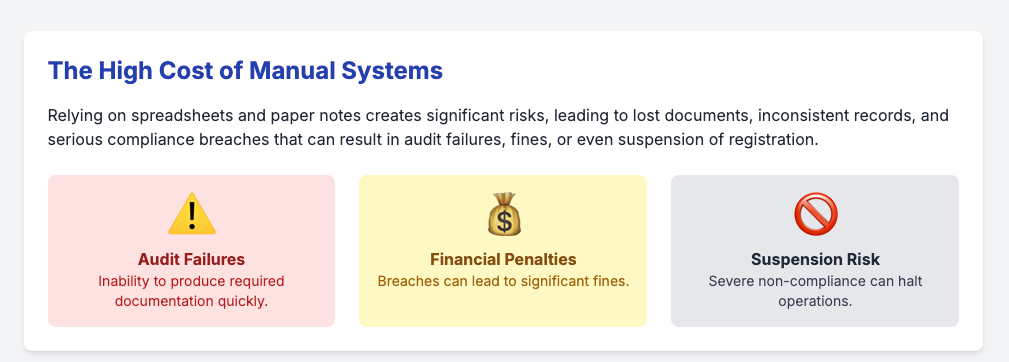
The Essential NDIS Software Compliance Checklist Every Provider Needs
The Compliance Checklist Features to Look for in NDIS Software
The National Disability Insurance Scheme (NDIS) has a complex and ever-changing regulatory landscape. For providers, staying on top of compliance isn't just a bureaucratic chore—it's the foundation for providing safe, high-quality services and building a sustainable business.
But if you're still relying on spreadsheets, paper notes, and a patchwork of different tools, you know how quickly that can turn into an overwhelming administrative burden. The risks of manual systems are high, from lost documents and inconsistent records to serious compliance breaches that can lead to audit failures, fines, and even the suspension of your registration.
The good news? Purpose-built NDIS software can transform this challenge. It moves your business from a reactive state of "last-minute scramble" to a proactive, continuous state of "audit-readiness." The key is knowing what to look for.

Here is a definitive checklist of essential features to guide your search for the perfect NDIS software platform.
1. Governance & Operational Management
A strong compliance framework starts with solid governance. Your software should provide the tools to build and maintain a professional, organised operation.
-
Policy and Document Management: Look for a centralised, digital repository for all your policies, procedures, and forms. Auditors will scrutinise these documents, so having version control and easy-to-access, up-to-date files is non-negotiable.
-
Risk and Quality Management: The best platforms help you manage risk and drive continuous improvement. Features to look for include spaces to conduct self-assessments against the NDIS Quality Standards and tools to track participant feedback and quality management plans.
2. Secure & Comprehensive Record-Keeping
Poor record-keeping is a major red flag for auditors. An integrated software platform should serve as your single source of truth, digitising and centralising all your essential records.
-
Centralised Participant Files: The software should store all participant records—from service agreements and support plans to progress notes and incident reports—in one secure location. This ensures information is complete, easy to find, and accessible for both staff and auditors.
-
Real-Time Care Notes: Your support workers should have a mobile-friendly way to document progress notes and other critical information while in the field. This ensures your documentation is accurate, timely, and provides a clear, time-stamped audit trail.
-
Incident and Complaints Management: The platform should include robust features for staff to report incidents or complaints quickly and accurately. This includes automated workflows, escalation alerts to management, and a clear, time-stamped record of how the issue was resolved.
3. Workforce Management & Safeguarding
The safety and quality of care you deliver are directly linked to the competence and reliability of your workforce. Software can remove the risk of human error from this critical area.
-
Intelligent Rostering and Scheduling: Stop wasting time on manual rostering. Software should automate rostering, matching staff to clients based on their qualifications, availability, and skills. This reduces the risk of missed shifts and ensures the right person is always on the job.
-
Automated Compliance Alerts: This is a crucial feature. The platform should track staff certifications, mandatory training, and NDIS Worker Screening Checks. It should send automated reminders before these expire, preventing you from ever having unverified staff working with participants.
-
HR Management: Centralised staff profiles, training records, and performance reviews make it easy to provide auditors with evidence that your workforce is fully qualified and competent.
4. Financial Integrity & Billing Automation
Managing NDIS finances manually is a complex and inefficient process. The right software simplifies and automates this function, improving cash flow and ensuring compliance.
-
NDIS Pricing Integration: The software should automatically integrate with the NDIS Pricing Arrangements and Price Limits (PAPL). This ensures that every claim is priced accurately, preventing errors and non-compliance with the NDIA's rules.
-
Real-Time Budget Tracking: A key feature is the ability to track a participant's budget in real time, with alerts that prevent overruns. This provides transparency for everyone involved and ensures funding is managed responsibly.
-
Automated Invoicing & Bulk Claims: A strong platform streamlines the payment request process by automating invoicing and allowing for the bulk submission of claims to NDIA systems. This eliminates double data entry, reduces human error, and speeds up reimbursements.
The Right Platform Is a Strategic Investment

Choosing the right NDIS software isn't about finding a simple fix for an administrative problem. It's about making a strategic investment that empowers your entire organisation. An integrated platform doesn't just help you avoid the pitfalls of non-compliance—it enhances the quality of care you provide, drives operational efficiency, and builds a more confident and empowered workforce. By using this checklist, you can find a platform that will not only keep your business safe but will also help it thrive.
Sources & References
1. NDIS Quality and Safeguards Commission. NDIS Practice Standards and Quality Indicators. Retrieved from https://www.ndiscommission.gov.au/providers/provider-registration/ndis-practice-standards-and-quality-indicators
2. NDIS Quality and Safeguards Commission. Common mistakes for providers. Retrieved from https://www.ndiscommission.gov.au/providers/provider-compliance/common-mistakes-providers
3. NDIS Quality and Safeguards Commission. NDIS Provider Registration. Retrieved from
https://www.ndiscommission.gov.au/providers/provider-registration
4. Australian Government, Department of Social Services. Review of the National Disability Insurance Scheme. Final Report.
5. National Disability Insurance Agency. NDIS Provider Toolkit. Retrieved from
https://www.ndis.gov.au/providers/provider-toolkit
6. Australian Competition and Consumer Commission (ACCC) & NDIS Quality and Safeguards Commission. Fair and Ethical: A Guide for NDIS Providers. Retrieved from https://www.accc.gov.au/publications/fair-and-ethical-a-guide-for-ndis-providers
7. NDIS Quality and Safeguards Commission. Modules for NDIS Practice Standards. Retrieved from https://www.ndiscommission.gov.au/providers/ndis-practice-standards/modules
8. NDIS Quality and Safeguards Commission. Changes to the NDIS Practice Standards. Retrieved from https://www.ndiscommission.gov.au/resources/changes-ndis-practice-standards
9. NDIS Quality and Safeguards Commission. Understanding the Audit Process. Retrieved from https://www.ndiscommission.gov.au/providers/provider-registration/audits
10. NDIS Quality and Safeguards Commission. Stages of an NDIS Audit. Retrieved from
https://www.ndiscommission.gov.au/providers/provider-registration/audits/stages-audit


